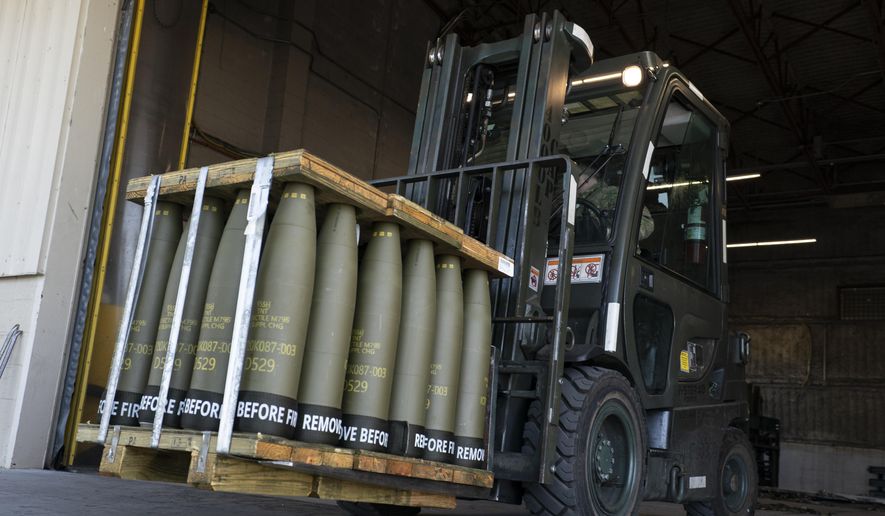President Biden’s proposed $842 billion defense budget for fiscal year 2024 focuses on countering China in Asia and Russia in Ukraine, but also targets a problem closer to home: U.S. armaments stockpiles that are running low as they strain to keep Ukraine armed against the Russian invaders.
Deputy Defense Secretary Kathleen Hicks defended Mr. Biden’s budget blueprint in a briefing Monday, while acknowledging that U.S. arms stockpiles must be refilled having been stressed by a year of support for Kyiv’s fight against Moscow. Some critics of the U.S. and Western campaign in support of Ukraine have cited the strain on the Pentagon’s arsenal as one reason to scale back.
The Defense Department wants $30.6 billion for munitions in 2024, a 12% increase above the previous fiscal year and a nearly 50% jump from just five years ago. The Pentagon also wants to make “unprecedented” use of the new flexibility to spread out contracts over multiple years, a flexibility that Congress provided to get the most bang for the taxpayers’ buck, Ms. Hicks told reporters.
“When it comes to munitions, make no mistake: We are buying to the limits of the industrial base even as we are expanding those limits,” she said. “And, we are continuing to cut through red tape and accelerate timelines.”
Pentagon officials have admitted that U.S. arms manufacturers are struggling to keep Ukraine supplied with ammunition as the clash with Russia has settled into a long-term grinding war of attrition.
“One of the lessons of this war is the very high consumption rates of conventional munitions. We are re-examining our own [stockpiles] and our own plans to make sure that we got it right,” Joint Chiefs of Staff Gen. Mark Milley told the Financial Times in an interview last month.
SEE ALSO: Pentagon says Russia supplying fuel for Chinese nuclear warheads
A January report by the Center for Strategic and International Studies think tank warned that the U.S. military faced depleted stocks of key weapons because of the strain of arming Ukraine, including Stinger surface-to-air missiles, 155mm howitzers and Javelin anti-tank missile systems.
Almost one-third of the Defense Department’s munitions dollars in the new budget would be focused on long-range weaponry — both hypersonic missiles and subsonic weapons. Ms. Hicks said the increases will focus on weapons considered most needed to prevail in the Indo-Pacific theater, including the Tomahawk cruise missile; the extended-range Joint Air-to-Surface Standoff Missile; the Long Range Anti-Ship Missile and the anti-ship capable SM-6 missile. The clear target of the deterrence is an increasingly aggressive and powerful China.
“Our goal is to deter, because competition does not mean conflict,” Ms. Hicks said. “Still, we must have the combat capability to win if we must fight.”
With Republicans now in charge of the House of Representatives, Mr. Biden’s funding proposal released last week is virtually certain to face a major rewrite by the end of the process. Top GOP members in Congress have already taken swipes at a budget they consider inadequate.
“The United States is facing the most complex and challenging set of threats to our national security in decades,” House Armed Services Committee Chairman Mike Rogers, Alabama Republican, said in a statement. “Unfortunately, the president has once again submitted a budget request that fails to take these threats seriously.”
The Pentagon says it wants to invest in several new weapons platforms, including additional guided-missile frigates and destroyers and Virginia-class submarines, along with other fifth-generation tactical and bomber aircraft.
SEE ALSO: Biden budget would boost Pentagon, but Republicans say not enough
The Defense Department’s budget also devotes more than $30 billion for enhanced space capabilities as the international competition in outer space intensifies.
“This is the largest [Defense Department] space budget ever,” Ms. Hicks said.
The Pentagon also wants more than $9 billion to greatly expand its Pacific Deterrence Initiative. The funding would provide better air basing, new missile warning and tracking architecture, and homeland defense upgrades for Hawaii and Guam.
• Mike Glenn can be reached at mglenn@washingtontimes.com.




Please read our comment policy before commenting.